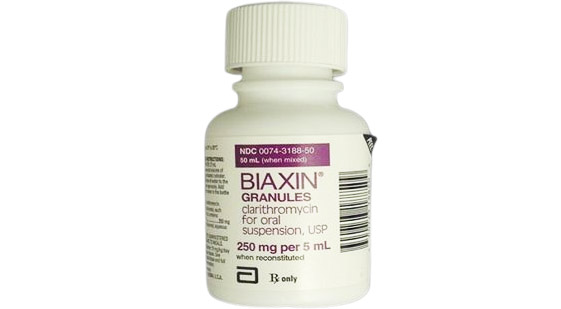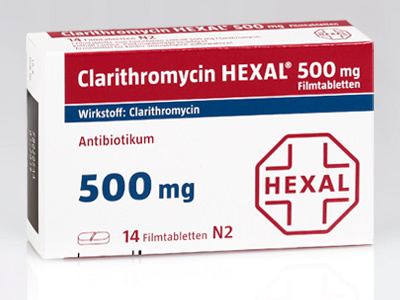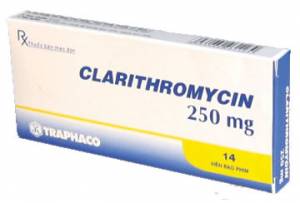Biaxin (Clarithromycin) is a macrolide antibiotic used to treat a wide variety of bacterial infections. It will not work for viral infections (such as the common cold and flu). This medication can also be combined with anti-ulcer medications to treat certain types of stomach ulcers.
What is Clarithromycin?
Clarithromycin, produced under the brand name Biaxin, is a semi-synthetic macrolide antibiс, effective against aerobic and anaerobic Gram-positive and Gram-negative bacteria. This makes the drug a versatile option in clinical settings. Clarithromycin works by inhibiting bacterial protein synthesis and preventing the growth and reproduction of bacteria.
The drug is available in various forms: immediate-release tablets, extended-release tablets, and oral suspension. It is designed for effective administration in treating infections such as pneumonia, strep throat, and skin infections. Clarithromycin is recognized for its ability to penetrate tissues effectively, which enhances its therapeutic efficacy against localized infections.
Indications for Adult Patients
For adults, Biaxin is commonly indicated in the following cases:
- pharyngitis/tonsillitis due to Streptococcus pyogenes;
- acute maxillary sinusitis caused by Haemophilus influenzae, Moraxella catarrhalis, or Streptococcus pneumoniae;
- acute bacterial exacerbation of chronic bronchitis due to Haemophilus influenzae, Haemophilus parainfluenza, Moraxella catarrhalis, or Streptococcus pneumoniae:
- community-acquired pneumonia due to Haemophilus influenzae, Mycoplasma pneumoniae, Streptococcus pneumoniae, or Chlamydia pneumoniae (TWAR);
- acute bacterial exacerbation of chronic bronchitis due to Haemophilus influenzae, Haemophilus parainfluenza, Moraxella catarrhalis, or Streptococcus pneumoniae;
- uncomplicated skin and skin structure infections due to Staphylococcus aureus or Streptococcus pyogenes (Abscesses usually require surgical drainage):
- disseminated mycobacterial infections due to Mycobacterium avium or Mycobacterium intracellular.
Indications for Children
For children, Biaxin is commonly indicated in the following cases:
- pharyngitis/tonsillitis due to Streptococcus pyogenes;
- community-acquired pneumonia due to Mycoplasma pneumoniae, Streptococcus pneumoniae, or Chlamydia pneumoniae (TWAR);
- acute maxillary sinusitis due to Haemophilus influenzae, Moraxella catarrhalis, or Streptococcus pneumoniae;
- acute otitis media due to Haemophilus influenzae, Moraxella catarrhalis, or Streptococcus pneumoniae;
- uncomplicated skin and skin structure infections due to Staphylococcus aureus or Streptococcus pyogenes (abscesses usually require surgical drainage);
- disseminated mycobacterial infections due to Mycobacterium avium or Mycobacterium intracellular.
Clinical Pharmacology
Clarithromycin is an antibiotic that is quickly absorbed into the gastrointestinal tract after oral intake. Its absolute bioavailability, particularly for a 250 mg tablet, is about 50%.
When taken with food, the absorption of a single 500 mg dose is slightly delayed, and peak plasma concentration is around 2.5 hours instead of 2 hours. Food increases the peak plasma concentration of the medicine by approximately 24% but does not change the overall bioavailability. While food does not affect the formation of its active metabolite, 14-OH clarithromycin, it does reduce its formation slightly, as indicated by an 11% decrease in the area under the plasma concentration-time curve (AUC). Therefore, the drug can be taken with or without food.
In healthy adults, peak plasma concentrations of the active ingredient are reached within 2 to 3 hours after dosing. Steady-state concentrations are achieved in about three days: approximately 1 to 2 µg/mL for a 250 mg dose taken every 12 hours and around 3 to 4 µg/mL for a 500 mg dose taken every 8 to 12 hours. The elimination half-life of Bioxin is about 3 to 4 hours for the lower dose and extends to 5 to 7 hours for the higher dose. The pharmacokinetics of Clarithromycin show slight nonlinearity at these doses.
For the metabolite 14-OH clarithromycin, steady-state peak concentrations are around 0.6 µg/mL with a 250 mg dose. They can reach up to 1 µg/mL with a higher dose. The elimination half-life for this metabolite is approximately 5 to 6 hours for the lower dose and increases to about 7 to 9 hours for the higher dose. Steady-state concentrations are typically reached within three to four days.
About 20% of a 250 mg dose is eliminated in urine as unchanged Clarithromycin. In comparison, this figure rises to about 30% for a 500 mg dose. For a liquid suspension form (250 mg), urinary excretion can be even higher at around 40%. The primary metabolite found in urine is still the active form, which accounts for an additional 10% to 15% of the total dose.
In patients with HIV who received similar doses, steady-state concentrations of Clarithromycin were comparable to those seen in healthy individuals. For those on higher doses (500 or 1000 mg), peak concentrations ranged from approximately 2 to 10 µg/mL. Interestingly, while steady-state levels of Clarithromycin remain consistent in patients with liver impairment, its metabolite levels are lower due to decreased formation; however, this is offset by increased renal clearance.
Extended-release formulations of Clarithromycin allow for prolonged absorption and provide lower peak plasma concentrations compared to immediate-release forms but maintain equivalent AUCs over an entire day. For instance, taking two extended-release tablets (500 mg each) once daily achieves peak plasma concentrations within about five to eight hours after ingestion. These extended-release tablets must be taken with food since fasting conditions can significantly reduce AUC.
In children requiring antibiotic treatment, doses of clarithromycin suspension generally lead to steady-state concentrations between 3 and 7 µg/mL for the parent drug and between 1 and 2 µg/mL for its metabolite when administered at a dosage of 7.5 mg/kg every 12 hours. In HIV-infected children on higher doses (15 mg/kg), peak concentrations can range from approximately 6 to 15 µg/mL.
Clarithromycin also effectively penetrates into middle ear fluid in children with otitis media. Studies have shown that food can influence plasma levels; for example, in adults taking clarithromycin suspension, food decreases peak plasma concentration slightly while increasing absorption duration.
Lastly, when combined with omeprazole (a proton pump inhibitor), Clarithromycin’s plasma levels increase significantly—both for itself and its metabolite—indicating that such combinations may enhance therapeutic efficacy by improving drug concentration in tissues where infections may occur.
Ingredients
Clarithromycin tablets contain active and inactive ingredients that facilitate their effectiveness and stability. Each tablet typically includes Clarithromycin (250 mg or 500 mg) as an active ingredient and inactive ingredients, such as Croscarmellose sodium, hypromellose, magnesium stearate, microcrystalline cellulose, and others that aid in tablet formulation and absorption.

What Are the Dosages of Clarithromycin?
Clarithromycin is a white to off-white crystalline powder. It is soluble in acetone, slightly soluble in methanol, ethanol, and acetonitrile, and practically insoluble in water.
Forms of Biaxin
Biaxin is available as an immediate-release tablet, extended-release tablet, and granule for oral suspension. The medicine is available in several dosages.
Each yellow oval film-coated immediate-release Biaxin tablet contains 250 mg or 500 mg of Clarithromycin.
NDC codes are NDC 0074-3368-60, NDC 0074-3368-11, NDC 0074-2586-60, and NDC 0074-2586-11.
Each yellow oval film-coated Biaxin XL tablet (Clarithromycin extended-release tablets) contains 500 mg of the active ingredient.
NDC codes are NDC 0074-3165-60, NDC 0074 3165-11, and NDC 0074-3165 41.
After constitution, each 5 mL of Biaxin suspension (Clarithromycin for oral suspension) contains 125 mg or 250 mg of the active ingredient. Each bottle of Biaxin granules contains 1250 mg (50 mL size), 2500 mg (50 and 100 mL sizes), or 5000 mg (100 mL size) of the active ingredient.
NDC codes for oral suspension are NDC 0074-3163-50, NDC 0074-3163-13, NDC 0074-3188-50, and NDC 0074-3188-13.
Dosages of Clarithromycin
The usual adult dosage for most infections is 250 mg every 12 hours or 500 mg every 8 to 12 hours; it depends on the severity of the infection.
The recommended daily dosage for children is 15 mg/kg/day divided every 12 hours for ten days (up to the adult dose).
Clarithromycin may be prescribed in combination with other medications for specific conditions like Helicobacter pylori eradication.
Biaxin tablets and Biaxin Granules (Clarithromycin for oral suspension) may be given with or without food. Biaxin XL (Clarithromycin extended-release tablets) should be taken with food. Biaxin XL tablets should be swallowed whole, not chewed, broken, or crushed.
If you missed the dose, take it as soon as you remember. Skip the missed dose if it is almost time for your next scheduled dose. Do not take extra medicine to make up for the missed dose.
Important Safety Information
Healthcare providers must consider several safety factors before treatment.
Prescribing Biaxin without a proven or strongly suspected bacterial infection or a prophylactic indication is unlikely to benefit the patient and increase the risk of developing drug-resistant bacteria.
This medicine may harm an unborn baby. Tell your doctor if you are pregnant or planning to become pregnant. Clarithromycin can pass into breast milk and may cause harm to the nursing baby. Tell your doctor if you are breast-feeding.
Caution is advised in patients with hepatic impairment as Clarithromycin is metabolized by the liver. Patients should be monitored for signs of liver dysfunction or severe allergic reactions during treatment.
Dose adjustments may be necessary for patients with renal impairment.
This medicine is not approved for children younger than 6 months old.
If you’ve ever had heart problems, Clarithromycin may cause a heart attack or stroke after you’ve taken this medicine. Tell your doctor if you have heart disease.
Continue treatment with Clarithromycin for the entire recommended duration, even if your symptoms become better. Additionally, missing doses may make you more susceptible to antibiotic-resistant infections in the future.
In patients who fail therapy, susceptibility testing should be done. If resistance to Clarithromycin is demonstrated, a non-clarithromycin-containing therapy is recommended.
The study was conducted with geriatric patients to examine how the body processes Clarithromycin in healthy older adults aged 65 to 81. When these individuals took 500 mg of the drug every 12 hours, their blood levels of Clarithromycin and its active form were higher than those seen in younger adults. This increase is likely linked to the natural decline in kidney function that comes with aging. However, older patients did not experience more side effects during clinical trials than younger patients. It is essential to consider and adjust the dosage for elderly patients with severe kidney issues.
Prescription
Clarithromycin requires a prescription from a licensed healthcare provider. It should be prescribed based on clinical judgment regarding the type of infection being treated and the patient’s medical history. Healthcare providers must also consider potential drug interactions when prescribing Clarithromycin.
Contraindications to Biaxin
There are several contraindications associated with clarithromycin use. Patients with known allergies to Clarithromycin or any component of the formulation should not take this medication. Concurrent use of this drug with certain medications (e.g., certain statins or anticoagulants) can lead to serious adverse effects due to increased drug levels. Patients with a history of liver disease should avoid Clarithromycin due to potential hepatotoxicity. Also, tell your doctor if you have the following conditions:
- coronary artery disease (clogged arteries);
- heart problems;
- myasthenia gravis;
- long QT syndrome (in you or a family member);
- liver disease;
- diabetes;
- kidney disease;
- an electrolyte imbalance (such as low levels of potassium or magnesium in your blood).
Side Effects
The majority of side effects observed in clinical trials were of a mild and transient nature.
Common side effects associated with Clarithromycin include nausea, vomiting, diarrhea, abdominal pain, and headaches.
Severe side effects can include liver dysfunction, allergic reactions (e.g., rash, itching), QT prolongation (which may lead to arrhythmias), fluttering in your chest, shortness of breath, and sudden dizziness (like you might pass out).
Patients may have liver problems (loss of appetite, upper stomach pain, tiredness, dark urine, clay-colored stools, jaundice) or kidney problems (little or no urination, swelling in your feet or ankles, feeling tired or short of breath). Patients should report any unusual symptoms or severe reactions to their healthcare provider immediately.
Antibiotic medicines can cause diarrhea. It may be a sign of a new infection. If you have watery or bloody diarrhea, call your doctor. Do not use anti-diarrhea medicine unless your doctor tells you to.
Interactions of Biaxin With Other Medicines
Clarithromycin has notable interactions with various medications due to its inhibition of CYP3A4 enzymes. Here is the list of the main interactions:
- pimozide;
- cisapride;
- lovastatin or simvastatin;
- lomitapide
- ergotamine or dihydroergotamine.
Concomitant administration of single doses of Clarithromycin and carbamazepine has increased plasma concentrations of carbamazepine. Blood level monitoring of carbamazepine may be considered.
Simultaneous administration of Biaxin tablets and didanosine to 12 HIV-infected adult patients resulted in no statistically significant change in didanosine pharmacokinetics.
Spontaneous reports in the post-marketing period suggest that concomitant administration of Clarithromycin and oral anticoagulants may potentiate the effects of the oral anticoagulants.
Healthcare providers should review all medications a patient is taking before treatment. Tell your doctor about all the medicines you currently take.

Overdose of Biaxin
In cases of overdose, symptoms may include gastrointestinal disturbances such as nausea and vomiting. Severe overdose could lead to more serious health issues such as liver damage or cardiac arrhythmias. Immediate medical attention is required if an overdose is suspected.
The prompt elimination of unabsorbed drug and supportive measures should treat adverse reactions accompanying overdosage. As with other macrolides, clarithromycin serum concentrations are not expected to be appreciably affected by hemodialysis or peritoneal dialysis.
Storage
Clarithromycin should be stored at room temperature (20°C to 25°C) away from moisture and heat. The oral suspension form must be refrigerated after reconstitution and discarded after a specified period, as indicated on the label.
Benefits of Using Biaxin
|
Benefit |
Description |
|
Broad-spectrum activity |
Effective against various Gram-positive and Gram-negative bacteria |
|
Tissue penetration |
High concentrations achieved in tissues enhance efficacy |
|
Convenient dosing |
Available in multiple forms for ease of administration |
|
Combination therapy |
Can be used effectively in combination regimens for H. pylori eradication |
Generic and Brand Names of Biaxin
Clarithromycin is marketed under several brand names:
- Biaxin;
- Biaxin BID;
- Omeclamox;
- Prevpac;
- Voquezna.
It is also available as a generic medication under its chemical name Clarithromycin.
Biaxin Brand Names in Different Countries
|
Country |
Brand Name |
|
United States |
Biaxin |
|
Canada |
Biaxin |
|
United Kingdom |
Klaricid |
|
Australia |
Biaxin |
|
Germany |
Klacid |
This table illustrates some variations in branding across different regions while maintaining the same active ingredient.
Clarithromycin (Biaxin) is an essential antibiotic for treating various bacterial infections due to its efficacy, safety profile, and versatility in clinical applications.
Proper understanding of its pharmacology, potential interactions, and contraindications ensures optimal patient care when utilizing this medication.
Check the additional information about Clarithromycin (Biaxin) here. The information is provided by the Food and Drug Administration (FDA).



 (3 votes, average: 3.67 out of 5)
(3 votes, average: 3.67 out of 5)













































